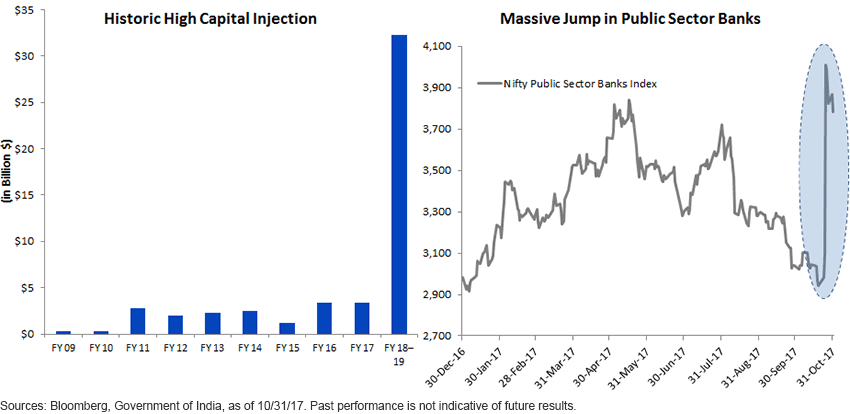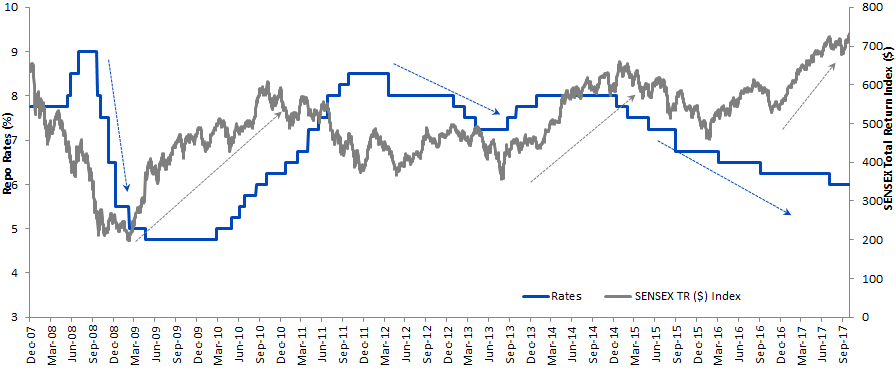Welcome To India’s Economic Jungle
In an African folk tale, a prince can only be coronated when he can sense the faintest noises of the jungle that even most alert predators tend to skip. The world of investing is similar. Surrounded by commotion and distractions, this economic jungle can lead even the most experienced predators to miss the whispering winds of change.
India’s equity markets have been roaring loudly, to the extent that some investors are simply taking it as background noise. A slew of positive news continues to come out of this Far East land. Here I will highlight two unrelated but key recent events:
- India’s credit markets getting freed from the grips of stressed loan books—a liquidity injection of $32 billion
- India’s ladder of reforms helping it jump a massive 30 spots in the World Bank’s Ease of Doing Business ranking
I will cover both of them in detail. I will try to be economical with words like “unprecedented,” “staggering” and “unheard of”; however, pardon my exuberance, for there is no other way to describe the changes occurring in this Eastern land!
Stressed Banking Books Coiling Credit Growth
India’s central bank, the Reserve Bank of India (RBI), has consecutively cut interest rates by 200 basis points (bps); however, retail banks, especially public sector banks, which account for two-thirds of financial assets, have been unwilling to completely transmit lower rates to an end person. The reason lies in their loan books, which are concentrated in the industrial sector. In the aftermath of the financial crisis, these loan books struggled, and thus 20% to 25% of net loans lent by these banks are now starting to default.
This has caused banks to be hesitant about further lending, resulting in a higher cost of borrowing, even for genuine entrepreneurs. The net result is stalled credit expansion, like prey trapped in the tight grip of a snake.
In a major announcement last month, the Modi government pledged $32 billion in capital for these beleaguered state banks—$20 billion will come from recapitalization bonds issued by the government, while banks will raise another $12 billion from markets. To give you a sense of the magnitude—this capital injection is higher than the cumulative injection of the last decade! (See Historic High Capital Injection chart below.)
Most public sector banks saw their stock prices jump more than 25%, and Moody’s, a prominent credit rating agency, said that the amount of capital pledged is enough to address the solvency challenge and recapitalize banks adequately. This means that credit in India’s economy could be out of the grips of frozen lending!
(Click on image to enlarge)

A Ladder to Climb 30 Rungs in World Bank Index (i.e., Economic Reforms!)
In the popular Indian board game Snakes and Ladders, rolling a dice could potentially get you a ladder, bringing you closer to the finish or to a snake, which could demote you back to the start. As a kid, I always wished for a ladder to jump ahead, but unfortunately I mostly got snakes. It seems like this economy has created its own ladder. The World Bank, in its much-emphasized Ease of Doing Business index, elevated India by 30 places in its 2017 ranking, a big recognition of the reform implementation by an external and powerful multilateral institution.
Most of India’s jump in ranking was driven by its ladder of reforms, such as implementation of a bankruptcy code, access to credit, power supplies and protections for minority investors. In October 2015, when Jeremy Schwartz and I spoke with the then finance minister, Jayant Sinha, he was in the process of designing these policies. Thus, the speed at which they have been implemented is staggering.
This is also the first time that India is in the top five nations in one parameter (i.e., it ranked No. 4 in “protecting interest of minority investors”). Below is the evolution of India’s ranking:
- 2014: 142/190
- 2015: 130/190
- 2016: 130/190
- 2017: 100/190
A jump of 30 spots in a single year by an economy as big as India is unheard of and boosts our confidence in India’s economic ladder of reforms.
Conclusion: Roaring Markets
India’s SENSEX is up by about 35% for the year,1 roaring loud and clear for the changes in the economy. I want to revisit this chart that I showed the first time in 2016.
Historically, consecutive rate cuts by RBI have led to equities delivering double-digit returns over the following year. Since January 2015, RBI has cut 200 bps, with the most recent rate cut coming in August 2017.
SENSEX Historically Delivered Double-Digit Returns to Consecutive Rate Cuts with a Lag
12/31/07–10/31/17
(Click on image to enlarge)

(Click on image to enlarge)

Until now, there has only been a partial transmission of lower rates to the economy. In spite of this, the market has responded with double digits so far. When you combine a complete transmission of cheaper credit, now poised to happen, with a cocktail of ongoing reforms and their benefits, I think India’s market is just starting a multiple-year bull run.
Morgan Stanley estimates that India’s equity market could potentially triple in the next five years. 2 We believe investors should stay focused on profitable companies and on investing across the complete breadth of equity markets.
In my opinion, investors should not ignore this loud and roaring tiger from the economic jungles of emerging markets.
Disclaimer: Investors should carefully consider the investment objectives, risks, charges and expenses of the Funds before investing. U.S. investors only: To obtain a prospectus containing this ...
more


